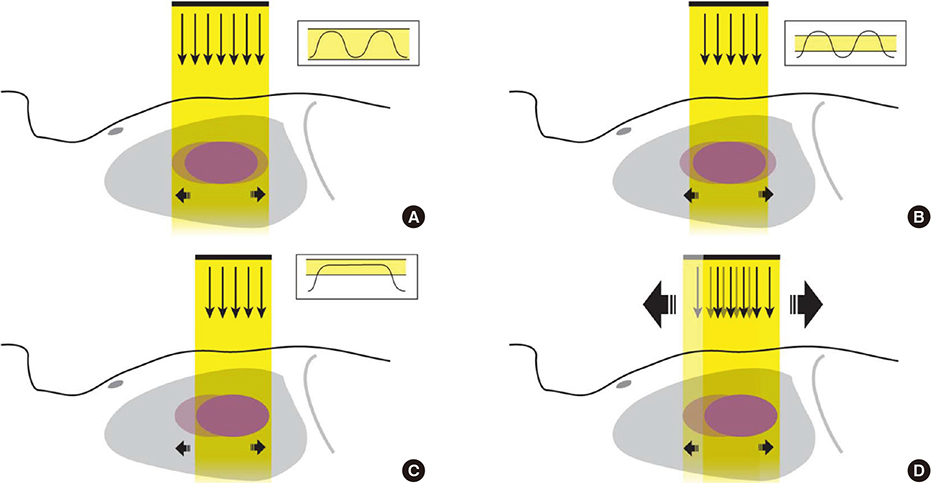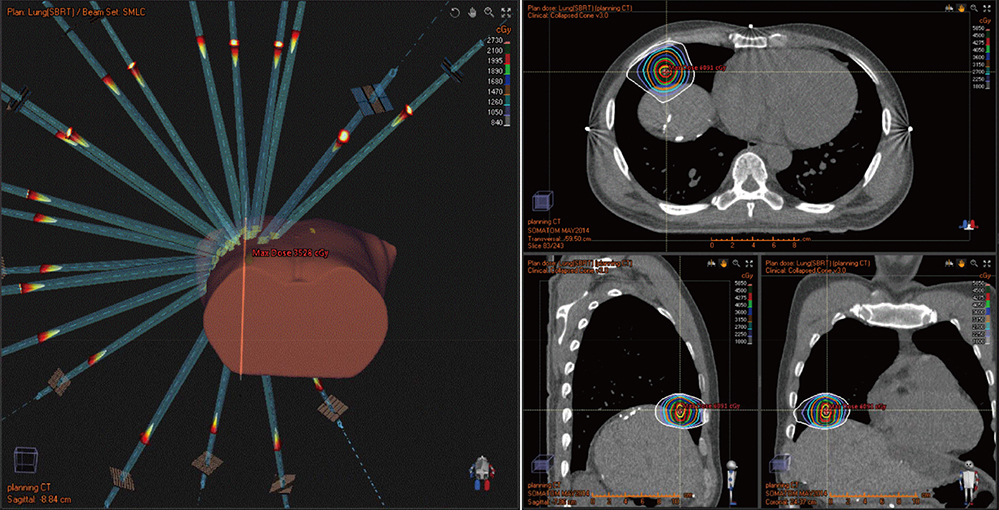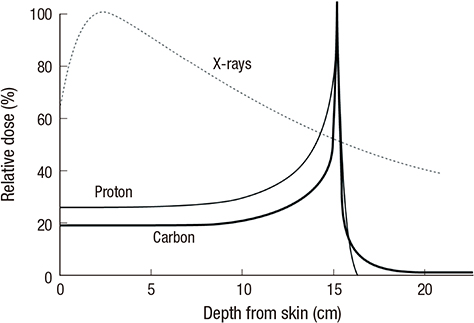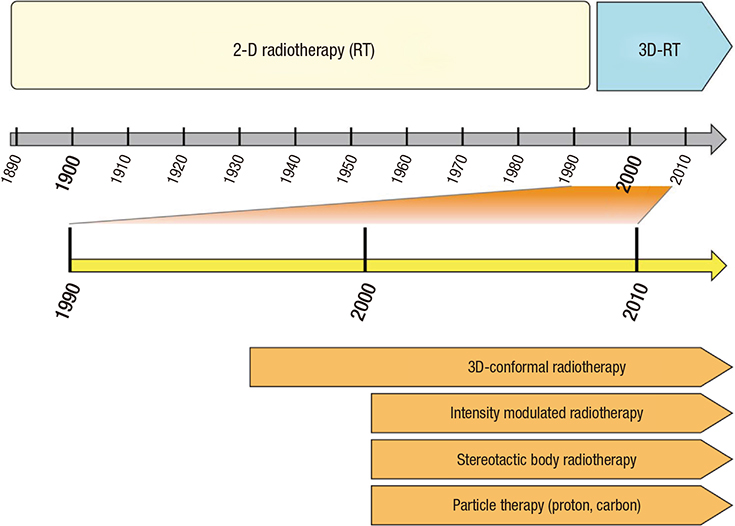J Korean Med Sci.
2016 Feb;31(Suppl 1):S75-S87. 10.3346/jkms.2016.31.S1.S75.
Evolving Clinical Cancer Radiotherapy: Concerns Regarding Normal Tissue Protection and Quality Assurance
- Affiliations
-
- 1Department of Radiation Oncology, Yonsei University College of Medicine, Seoul, Korea. jjhmd@yuhs.ac
- KMID: 2363384
- DOI: http://doi.org/10.3346/jkms.2016.31.S1.S75
Abstract
- Radiotherapy, which is one of three major cancer treatment methods in modern medicine, has continued to develop for a long period, more than a century. The development of radiotherapy means allowing the administration of higher doses to tumors to improve tumor control rates while minimizing the radiation doses absorbed by surrounding normal tissues through which radiation passes for administration to tumors, thereby reducing or removing the incidence of side effects. Such development of radiotherapy was accomplished by the development of clinical radiation oncology, the development of computers and machine engineering, the introduction of cutting-edge imaging technology, a deepened understanding of biological studies on the effects of radiation on human bodies, and the development of quality assurance (QA) programs in medical physics. The development of radiotherapy over the last two decades has been quite dazzling. Due to continuous improvements in cancer treatment, the average five-year survival rate of cancer patients has been close to 70%. The increases in cancer patients' complete cure rates and survival periods are making patients' quality of life during or after treatment a vitally important issue. Radiotherapy is implemented in approximately 1/3 to 2/3s of all cancer patients; and has improved the quality of life of cancer patients in the present age. Over the last century, as a noninvasive treatment, radiotherapy has unceasingly enhanced complete tumor cure rates and the side effects of radiotherapy have been gradually decreasing, resulting in a tremendous improvement in the quality of life of cancer patients.
Keyword
MeSH Terms
Figure
Reference
-
1. Timmerman R, Paulus R, Galvin J, Michalski J, Straube W, Bradley J, Fakiris A, Bezjak A, Videtic G, Johnstone D, et al. Stereotactic body radiation therapy for inoperable early stage lung cancer. JAMA. 2010; 303:1070–1076.2. Jung IH, Song SY, Jung J, Cho B, Kwak J, Je HU, Choi W, Jung NH, Kim SS, Choi EK. Clinical outcome of fiducial-less CyberKnife radiosurgery for stage I non-small cell lung cancer. Radiat Oncol J. 2015; 33:89–97.3. Zaider M, Minerbo GN. Tumour control probability: a formulation applicable to any temporal protocol of dose delivery. Phys Med Biol. 2000; 45:279–293.4. Gay HA, Niemierko A. A free program for calculating EUD-based NTCP and TCP in external beam radiotherapy. Phys Med. 2007; 23:115–125.5. Purdy JA. 3D treatment planning and intensity-modulated radiation therapy. Oncology (Williston Park). 1999; 13:155–168.6. Capelle L, Mackenzie M, Field C, Parliament M, Ghosh S, Scrimger R. Adaptive radiotherapy using helical tomotherapy for head and neck cancer in definitive and postoperative settings: initial results. Clin Oncol (R Coll Radiol). 2012; 24:208–215.7. Guckenberger M, Richter A, Wilbert J, Flentje M, Partridge M. Adaptive radiotherapy for locally advanced non-small-cell lung cancer does not underdose the microscopic disease and has the potential to increase tumor control. Int J Radiat Oncol Biol Phys. 2011; 81:e275–e282.8. Liesenfeld SM, Wendt TG. Clinical Implications of 3D-Conformal Radiotherapy. Onkologie. 2000; 23:590–592.9. Low D. 4D imaging and 4D radiation therapy: a New Era of therapy design and delivery. Front Radiat Ther Oncol. 2011; 43:99–117.10. Intensity Modulated Radiation Therapy Collaborative Working Group. Intensity-modulated radiotherapy: current status and issues of interest. Int J Radiat Oncol Biol Phys. 2001; 51:880–914.11. Gutiérrez AN, Westerly DC, Tomé WA, Jaradat HA, Mackie TR, Bentzen SM, Khuntia D, Mehta MP. Whole brain radiotherapy with hippocampal avoidance and simultaneously integrated brain metastases boost: a planning study. Int J Radiat Oncol Biol Phys. 2007; 69:589–597.12. Kim KH, Cho BC, Lee CG, Kim HR, Suh YG, Kim JW, Choi C, Baek JG, Cho J. Hippocampus-sparing whole-brain radiotherapy and simultaneous integrated boost for multiple brain metastases from lung adenocarcinoma: early response and dosimetric evaluation. Technol Cancer Res Treat. 2015; Forthcoming.13. Schulz-Ertner D, Jäkel O, Schlegel W. Radiation therapy with charged particles. Semin Radiat Oncol. 2006; 16:249–259.14. Dawson LA, Sharpe MB. Image-guided radiotherapy: rationale, benefits, and limitations. Lancet Oncol. 2006; 7:848–858.15. Tanderup K, Viswanathan AN, Kirisits C, Frank SJ. Magnetic resonance image guided brachytherapy. Semin Radiat Oncol. 2014; 24:181–191.16. Lee RJ, Suh HS, Lee KJ, Lim S, Kim Y, Kim S, Choi J. A magnetic resonance-based seed localization method for I-125 prostate implants. J Korean Med Sci. 2007; 22:Suppl. S129–S133.17. Sadozye AH, Reed N. A review of recent developments in image-guided radiation therapy in cervix cancer. Curr Oncol Rep. 2012; 14:519–526.18. Hendry JH. Radiation biology and radiation protection. Ann ICRP. 2012; 41:64–71.19. Cho J, Kodym R, Seliounine S, Richardson JA, Solberg TD, Story MD. High dose-per-fraction irradiation of limited lung volumes using an image-guided, highly focused irradiator: simulating stereotactic body radiotherapy regimens in a small-animal model. Int J Radiat Oncol Biol Phys. 2010; 77:895–902.20. Hong ZY, Lee HJ, Choi WH, Lee YJ, Eun SH, Lee JI, Park K, Lee JM, Cho J. A preclinical rodent model of acute radiation-induced lung injury after ablative focal irradiation reflecting clinical stereotactic body radiotherapy. Radiat Res. 2014; 182:83–91.21. Travis LB, Ng AK, Allan JM, Pui CH, Kennedy AR, Xu XG, Purdy JA, Applegate K, Yahalom J, Constine LS, et al. Second malignant neoplasms and cardiovascular disease following radiotherapy. J Natl Cancer Inst. 2012; 104:357–370.22. Koshy M, Rich SE, Mahmood U, Kwok Y. Declining use of radiotherapy in stage I and II Hodgkin’s disease and its effect on survival and secondary malignancies. Int J Radiat Oncol Biol Phys. 2012; 82:619–625.23. Welte B, Suhr P, Bottke D, Bartkowiak D, Dörr W, Trott KR, Wiegel T. Second malignancies in high-dose areas of previous tumor radiotherapy. Strahlenther Onkol. 2010; 186:174–179.24. Doi K, Mieno MN, Shimada Y, Yonehara H, Yoshinaga S. Meta-analysis of second cancer risk after radiotherapy among childhood cancer survivors. Radiat Prot Dosimetry. 2011; 146:263–267.25. Zelefsky MJ, Pei X, Teslova T, Kuk D, Magsanoc JM, Kollmeier M, Cox B, Zhang Z. Secondary cancers after intensity-modulated radiotherapy, brachytherapy and radical prostatectomy for the treatment of prostate cancer: incidence and cause-specific survival outcomes according to the initial treatment intervention. BJU Int. 2012; 110:1696–1701.26. Kutcher GJ, Coia L, Gillin M, Hanson WF, Leibel S, Morton RJ, Palta JR, Purdy JA, Reinstein LE, Svensson GK, et al. Comprehensive QA for radiation oncology: report of AAPM Radiation Therapy Committee Task Group 40. Med Phys. 1994; 21:581–618.27. Klein EE, Hanley J, Bayouth J, Yin FF, Simon W, Dresser S, Serago C, Aguirre F, Ma L, Arjomandy B, et al. Task Group 142 report: quality assurance of medical accelerators. Med Phys. 2009; 36:4197–4212.28. Moran JM, Dempsey M, Eisbruch A, Fraass BA, Galvin JM, Ibbott GS, Marks LB. Safety considerations for IMRT: executive summary. Pract Radiat Oncol. 2011; 1:190–195.29. Prescribing, recording, and reporting photon-beam intensity-modulated radiation therapy (IMRT): contents. J ICRU. 2010; 10:NP.30. Furlow B. IMRT guidelines aim to prevent “catastrophic” errors. Lancet Oncol. 2011; 12:836.31. Ford EC, Gaudette R, Myers L, Vanderver B, Engineer L, Zellars R, Song DY, Wong J, Deweese TL. Evaluation of safety in a radiation oncology setting using failure mode and effects analysis. Int J Radiat Oncol Biol Phys. 2009; 74:852–858.32. Huq MS, Fraass BA, Dunscombe PB, Gibbons JP Jr, Ibbott GS, Medin PM, Mundt A, Mutic S, Palta JR, Thomadsen BR, et al. A method for evaluating quality assurance needs in radiation therapy. Int J Radiat Oncol Biol Phys. 2008; 71:S170–S173.33. Kry SF, Molineu A, Kerns JR, Faught AM, Huang JY, Pulliam KB, Tonigan J, Alvarez P, Stingo F, Followill DS. Institutional patient-specific IMRT QA does not predict unacceptable plan delivery. Int J Radiat Oncol Biol Phys. 2014; 90:1195–1201.34. Ferreira IH, Dutreix A, Bridier A, Chavaudra J, Svensson H. The ESTRO-QUALity assurance network (EQUAL). Radiother Oncol. 2000; 55:273–284.
- Full Text Links
- Actions
-
Cited
- CITED
-
- Close
- Share
- Similar articles
-
- The Results of the Survey about Present Situation of Quality Assurance for Radiotherapy Machine of Korea
- Quality Assurance of Gastric Cancer Surgery
- Quality Assurance and Performance Evaluation of PET/CT
- Use of Statistical Process Control for Quality Assurance in Radiation Therapy
- Radiotherapy in the Region of the Head and Neck and the Consequential Changes in Normal Tissues






